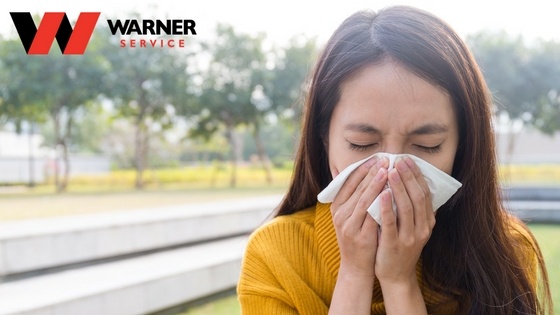
Did you know that there is a difference between allergens and pathogens? Only about 1 to 2 percent of all germs are pathogenic, which means they can make you sick, while allergenic germs trigger allergy-like symptoms. This can mean sneezing, itchy and watery eyes, or a stuffy nose. So, how do you get rid of either type?
While many of us do not have time to conduct a home mold audit, we can do a few chores to help our sinuses out. Here is Warner Service’s guide on how you tackle each room’s allergen and pathogen elimination:
Basement
Basements are known for being damp and cold, meaning they are perfect for mold. To remove insects and mold from the basement, fix any leaks in the foundation and pipes, especially near the water heater and central HVAC unit. If you do see mold in your home, immediately call a professional to remove it.
Warm, damp environments are a breeding ground for mold spores, which means your bathroom is a prime candidate.
To avoid mold growth, fix leaky pipes in the bathroom, and wipe down the sink and counter daily to remove puddles. You should also use an exhaust fan when showering to keep air circulating. Lastly, avoid using whole-home air fresheners, and wash bathroom mats and towels once per week to remove any pathogen growth.
Bedroom
It is a gross thought that allergens and pathogens stir in the air while you are sound asleep, but it is true. To combat them, use a special mite-proof casing for the mattress, pillows, and box spring. Wash bedding (using bleach when possible) once per week in hot water to kill any dust mites, and replace pillows every 5 years and the mattresses every decade. Keep the space under your bed clutter-free, too.
Unfortunately, one of the biggest culprits of dander, pollen, and mold is your furry friend. Avoid getting these germs in your bed by keeping your cat or dog on the floor and out of the bedroom.
Believe it or not, cockroaches are a huge offender. Their waste and microscopic shedding are allergenic, and mold is also a big deal breaker in the kitchen.
To keep all of these unwanted contaminants at bay, never leave food or garbage out. Store everything in airtight containers, and wipe the stovetop off immediately after cooking. Remove crumbs and/or spilled liquids on countertops, and always wash the dishes as soon as possible.
If you want a more foolproof way, invest in insect traps. They are better for those who have allergies as using liquid or aerosol pesticides can make symptoms worse.
Living Room
Dust mites and mold easily make their way onto furniture and carpets to trigger illness and allergies. To get rid of these pests once and for all, use a device with an HEPA filter to vacuum the furniture and curtains once per week (or eliminate curtains, and opt for leather, plastic, or metal furniture). Like in the bedroom, keep your furry pet on the floor, and switch from carpet to hardwood.
Summer allergens and pathogens in your home are winding down. However, fall will bring its set of worries. We are talking about an increase in mold, dust mites, and ragweed (which can be avoided by washing your hands often; avoiding bananas, melons, and chamomile; and rinsing out your nose).
To avoid sneezing all season, follow our tips for disinfecting each room in your home. If you want a more detailed answer on how to eliminate these germs, download our Allergens and Pathogens Checklist by clicking below.


